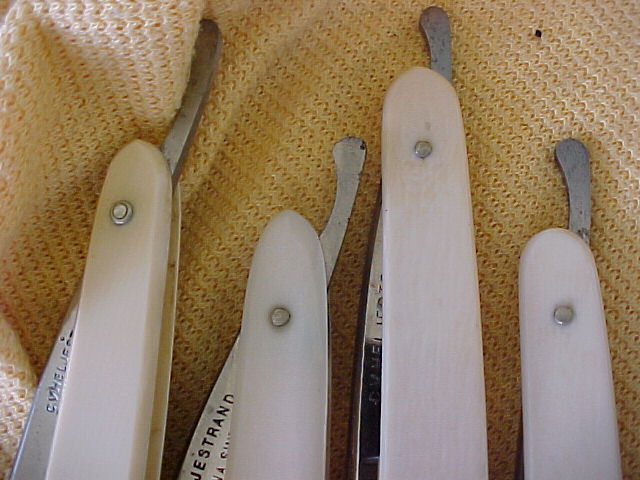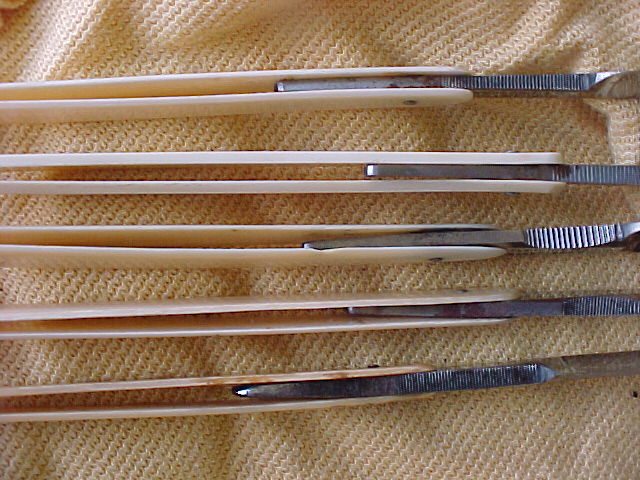Results 1 to 10 of 27
Thread: Real Ivory or Faux?
-
08-11-2013, 03:21 PM #1
 Real Ivory or Faux?
Real Ivory or Faux?
Is there a sure-fire way to tell whether scales are real ivory or not?
---------------------------------------------------
Love new things that look old, and old things, made to look new again!
-
08-11-2013, 03:23 PM #2Senior Member


- Join Date
- Jan 2011
- Location
- Roseville,Kali
- Posts
- 10,432
Thanked: 2027
Post a pic
-
08-11-2013, 04:02 PM #3

Here's a photo that may help, the one in the top photo furthest to the left is celluloid and the others are ivory. You may be able to see a hint of grain. The next photo, the second one from the top is celluloid, notice how much thicker the scales are ........ ;


-
The Following User Says Thank You to JimmyHAD For This Useful Post:
MJC (08-11-2013)
-
08-11-2013, 04:43 PM #4

Looks like the 3 on the right are ivory in the first pic, Definitely not the 2nd one down in the second pic. JMO
"Don't be stubborn. You are missing out."
I rest my case.
-
08-11-2013, 04:58 PM #5

A hot glowing pin pressed on the inside of the scales works fine!
Hur Svenska stålet biter kom låt oss pröfva på.
-
08-11-2013, 05:02 PM #6Senior Member


- Join Date
- Jan 2011
- Location
- Roseville,Kali
- Posts
- 10,432
Thanked: 2027
I new the pin guys would come out
 If possible.post a pic taken in natural sunlight at an oblique angle.
If possible.post a pic taken in natural sunlight at an oblique angle.
-
08-11-2013, 05:06 PM #7
-
08-11-2013, 05:36 PM #8

Listen to Pixelfixed. That is a far better, less destructive test.
There's no need for hot pins if you've got sunlight and a digital camera, and THAT test will tell you whether it's ivory or bone, which the hot pin test will not unless you really know what you're doing.
Some bone is very obviously bone, but not all of it, just as some ivory is very obviously ivory. There's a middle gray area and bright sun and a camera will sort that right out.
What you do is take a picture in very strong, directional light (IE, the angle of the light is coming strongly from the side of the material). Just the sunlight might be enough to see the patterns, but if not, take your picture and take it into any simple photo editing software and turn the contrast all the way up. The patterns will become apparent. Look through this thread, the pictures there will give you what you need.-Zak Jarvis. Writer. Artist. Bon vivant.
-
08-11-2013, 06:21 PM #9

Good info! A hot pin would not differentiate ivory from bone and, if hot enough, would badly mark or possibly set celluloid on fire! Pictures are really best. IMO, the OP should carefully study the two on the right in the first pic. I think these 2 are absolutely ivory and should be a good example to compare to. As you have handled and seen a few, you will not be mistaken in the future. Collarless pinning is most often an indicator of ivory/bone, esp in English and Swedish razors, but there are exceptions. Certainly Ivory and bone do not warp and are somewhat thinner than Cell. As in the second pic, second razor down. The scales are thick, pinned with collars, and are bending under the top pins. Celluloid!
"Don't be stubborn. You are missing out."
I rest my case.
-
08-11-2013, 07:00 PM #10At this point in time...




- Join Date
- Jun 2007
- Location
- North Idaho Redoubt
- Posts
- 27,054
- Blog Entries
- 1
Thanked: 13249
It is hard to tell Bone from Ivory on razor scales,
Jimmy's pics show quite well how obvious Celluloid is from thickness to pinning and even shape and just plain feel As the saying goes once you hold real Ivory scales you won't ever ask again..
As the saying goes once you hold real Ivory scales you won't ever ask again..
Both Ivory and Bone are very Thin .045-.065 is the average Bone sometimes has a slight contour (curve/bevel) to the outside that is a good tell, pinning is sometimes a tell also but not always..
The Schreger lines in the Ivory vs the Holes in bone are a great tell if they are visible..
Posting good pics here is a solid bet that we can tell Natural vs Manmade and a possible bet that we can tell Bone from Ivory..


 16Likes
16Likes LinkBack URL
LinkBack URL About LinkBacks
About LinkBacks






 Reply With Quote
Reply With Quote


